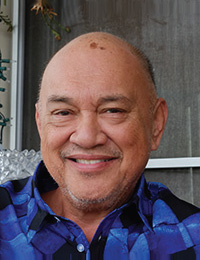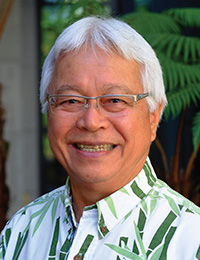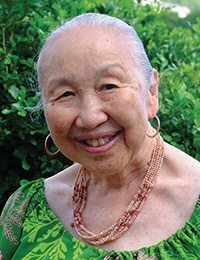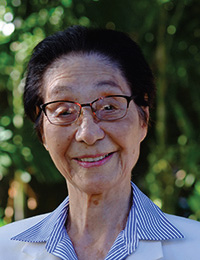
NEWS RELEASE – for immediate release
January 20, 2020
Contact: Derrick Inouye 808-522-9200, dinouye@honpahi.org
Registration: 2020 Living Treasures reservation form
2020 LIVING TREASURES OF HAWAII TO BE HONORED AT 45th ANNUAL PROGRAM
HONOLULU, Hawaii – A warrior for the Hawaiian language, an icon in the world of music and hula, a master and teacher in the ancient art of brush painting, and a passionate volunteer committed to instilling the values of aloha. These four individuals and their selfless contributions to our society are why they have been chosen as this year’s Living Treasures of Hawaii.
The 45th Living Treasures of Hawaii Recognition Program and Gala Luncheon will be held on Saturday, February 8, 2019, 11 a.m. in the Coral Ballroom at the Hilton Hawaiian Village Waikiki Beach Resort.
The “Living Treasures of Hawaii” program was created by the Honpa Hongwanji Mission of Hawaii in 1976, inspired by the Living National Treasures of Japan. Bishop Yoshiaki Fujitani started the program at the suggestion of the late Paul Yamanaka, a local insurance executive, who wanted to honor those unique to the islands who demonstrate excellent and high standards of achievement in their particular fields and continue to make a significant contribution towards enriching our society.
The following individuals have been chosen as the 2020 Living Treasurers of Hawaii:
Robert Cazimero
 Through his work in nearly every aspect of the performing arts, Robert Uluwehionapuaikawekiuokalani Cazimero has secured his position as an indelible influencer of Hawaiian music and dance.
Through his work in nearly every aspect of the performing arts, Robert Uluwehionapuaikawekiuokalani Cazimero has secured his position as an indelible influencer of Hawaiian music and dance.
Cazimero’s legacy in the Hawaiian music recording industry has spanned over four decades from his start with the iconic trio, Sunday Manoa, to 26 albums with the Brothers Cazimero and six solo albums. He has received 25 Na Hoku Hanohano awards and was nominated for a Grammy in 2005 for Best Hawaiian Music Album. The Brothers Cazimero received the Lifetime Achievement Award by the Hawaii Academy of Recording Artists in 2008. The roster of former students who have been influenced and mentored by Cazimero and have gone on to highly successful careers in the Hawaiian music industry are countless.
Cazimero’s passion for hula began while as a student at Kamehameha Schools under the teachings of Kumu Hula Maiki Aiu Lake. He became a Kumu Hula in 1973 and it was Lake’s vision of an all-male halau that Cazimero and Wayne Keahi Chang manifested into Halau Na Kamalei o Lililehua, known as the only all male hula halau that exists in the world today. Under his tutelage, Cazimero has graduated three separate classes of kumu hula, has advanced hula dancers and created the non-profit Wahea Foundation, ensuring the rich teachings and traditions, particularly male hula, will continue to future generations.
Cazimero’s continues to contribute his time and talent in all areas of the arts: singer, dancer, musician, kumu hula, choreographer, recording artist, composer, chanter, and mentor. His music and hula have graced the stages from Carnegie Hall, Wolf Trap, Tokyo and the Hollywood Bowl. It is safe to say Robert Cazimero is an iconic star of Hawaiian entertainment and a conduit of Hawaiian language and culture through performing arts.
Larry Kimura
 A committed champion for the preservation and use of the Hawaiian language, Larry Lindsey Kimura, PhD, is known worldwide for his tremendous contributions in the revitalization of Hawaii’s only indigenous language.
A committed champion for the preservation and use of the Hawaiian language, Larry Lindsey Kimura, PhD, is known worldwide for his tremendous contributions in the revitalization of Hawaii’s only indigenous language.
As a teacher of Hawaiian language for nearly 50 years at both the University of Hawaii Manoa and Hilo campuses, as well as a leader in the curriculum development for the Hawaiian immersion schools, it is no exaggeration to say Kimura’s influence has touched multiple generations of Hawaiian language speakers from keiki to kupuna. He continues to contribute to the revitalization of the Hawaiian language as the chairperson of the Hawaiian Lexicon Committee for the Hale Kuamoo Hawaiian Language Center of the College focusing on Hawaiian curriculum development and teacher licensing for Hawaii’s immersion programs. He also is the first President and Co-Founder of Hawaii’s first Punana Leo Hawaiian language immersion preschools.
Kimura is a Co-Principal Investigator for a National Science Foundation and a National Endowment for the Humanities grant to digitize and archive spoken native Hawaiian speech. He has collected some 525 hours of first language Hawaiian speakers recorded during the Ka Leo Hawaii radio program starting in the 1970s, which stands as the largest collection of the spoken Native Hawaiian word. He is currently working on a digital repository to make these recordings accessible to future generations.
As a prolific composer, he is credited across 47 albums, tapes and CDs for his songs and chants. He also was one of the consultants in creating a Hawaiian language certification program for Hawaiian Airlines employees to encourage Hawaiian to be spoken and shared with passengers on board their flights.
Through Larry Kimura’s love and passion for the Hawaiian language, he is helping keep alive the history, beauty and essence of Hawaii.
Carolee Nishi
 Throughout her 51 years as a volunteer at the YWCA, Carolee Mei-Jen Kapuamaeole Nishi has inspired generations of students to practice and live the Hawaiian values of the Aloha spirit.
Throughout her 51 years as a volunteer at the YWCA, Carolee Mei-Jen Kapuamaeole Nishi has inspired generations of students to practice and live the Hawaiian values of the Aloha spirit.
Since 1969, Nishi has been a volunteer teacher of Hawaiian Studies at the Nu’uanu YMCA. What began as a free transition program for Micronesian immigrants and latchkey children, blossomed into a hula halau, Hula Hui O Kapunahala, whose students have gone on to become successful Hawaiian entertainers and educators.
Although she is of fifth-generation Chinese descent, Nishi has a passion for preserving the Hawaiian culture, which is evident as her students and families of the Hawaiian studies program are immersed in the Aloha values, which are practiced in lessons, rehearsals, preparations, and performances: Akahai (gentleness), Lokahi (unity), Oluolu (comfortable), Haahaa (humility), Ahounui (patience).
The program today remains at the same location and continues to attract hundreds of students of all ages and ethnicities from all parts of the island and the world, and its comprehensive curriculum has produced award-winning students in language and hula. More than a hula halau, the Hawaiian Studies program teaches the Hawaiian language and culture.
Nishi’s volunteer work has been recognized through numerous awards, but she has never been one to revel in the accolades, instead preferring to enjoy the accomplishments of her students. During her time as a volunteer, Nishi worked for 41 years at United Airlines and as a State Department of Education Hawaiian Studies teacher. Even while at the DOE, she voluntarily organized, produced and directed scores of May Day programs for the schools.
Carolee Nishi’s selfless generosity of her time, knowledge and passion with the young and old for more than half a century truly qualifies her as a living treasure.
Sachie Saigusa
 For much of her extraordinary 92 years, Sachie Saigusa has perpetuated the Japanese culture through the stroke of a brush.
For much of her extraordinary 92 years, Sachie Saigusa has perpetuated the Japanese culture through the stroke of a brush.
As a Buddhist minister’s wife arriving in Hawaii in 1956 with no English language ability but two degrees in Japanese Budo (naginata), degrees in primary and elementary education, along with a masters degree and certification as a social counselor and administrator from Japan, Saigusa coordinated the construction and renovation of Japanese language schools that had been closed during the war. Along with the Japanese language, she also was an instructor in tea ceremony, flower arrangement, cooking, music, dance, Japanese calligraphy, and naginata. For all these classes conducted over 23 years, she was never compensated simply because she was the minister’s wife.
Saigusa’s grandfather was a renowned sumie artist in Hiroshima, but it was under the tutelage of Master Sumie artist Juho Motomura that her dedication to the art of brush painting began. Before he retired in 1980, he selected Saigusa to become his successor and introduced her to the schools. Today, she is still the only sumie teacher accepted by the State Department of Education and still employed by the State DOE School for Adults.
To ensure the continuation of the art and to set up an established system and program for the instruction of sumie, in 2001, Saigusa founded the Sumie Society of Hawaii. Through this non-profit organization, some 30 students to date have become certified as instructors of the art form. Saigusa continues to teach classes today and the art work of her students are exhibited annually at Honolulu Hale.
Saigusa’s passion for sumie and her contribution to perpetuate this art form is only one of her many accomplishments. Some would say overcoming the adversities and challenges as a Hiroshima atomic bomb survivor as well as a seven time cancer survivor may be equally impressive.
Sumie is an art form where a simple brush stroke of the black on white creates a living image. In many ways, Sachie Saigusa’s life has reflected that simple beauty by not only being a vital cultural bridge between Japan and Hawaii, but enriching the lives of numerous individuals with her humbleness, grace and talent.
For more information on Living Treasures of Hawaii, please visit
our Living Treasures page or call (808) 522-9200.
# # #
